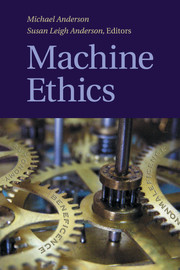Book contents
- Frontmatter
- Contents
- General Introduction
- PART I THE NATURE OF MACHINE ETHICS
- Introduction
- 1 The Nature, Importance, and Difficulty of Machine Ethics
- 2 Machine Metaethics
- 3 Ethics for Machines
- PART II THE IMPORTANCE OF MACHINE ETHICS
- PART III ISSUES CONCERNING MACHINE ETHICS
- PART IV APPROACHES TO MACHINE ETHICS
- PART V VISIONS FOR MACHINE ETHICS
Introduction
from PART I - THE NATURE OF MACHINE ETHICS
Published online by Cambridge University Press: 01 June 2011
- Frontmatter
- Contents
- General Introduction
- PART I THE NATURE OF MACHINE ETHICS
- Introduction
- 1 The Nature, Importance, and Difficulty of Machine Ethics
- 2 Machine Metaethics
- 3 Ethics for Machines
- PART II THE IMPORTANCE OF MACHINE ETHICS
- PART III ISSUES CONCERNING MACHINE ETHICS
- PART IV APPROACHES TO MACHINE ETHICS
- PART V VISIONS FOR MACHINE ETHICS
Summary
James moor, in “the nature, importance, and difficulty of machine Ethics,” discusses four possible ways in which values could be ascribed to machines. First, ordinary computers can be considered to be “normative agents” but not necessarily ethical ones, because they are designed with a purpose in mind (e.g., to prove theorems or to keep an airplane on course). They are technological agents that perform tasks on our behalf, and we can assess their performance according to how well they perform their tasks. Second, “ethical impact agents” not only perform certain tasks according to the way they were designed, but they also have an ethical impact (ideally a positive one) on the world. For example, robot jockeys that guide camels in races in Qatar have replaced young boys, freeing them from slavery. Neither of the first two senses of ascribing values to machines, Moor notes, involves “putting ethics into a machine,” as do the next two.
Third, “implicit ethical agents” are machines that have been programmed in a way that supports ethical behavior, or at least avoids unethical behavior. They are constrained in their behavior by their designers who are following ethical principles. Examples of such machines include ATMs that are programmed not to cheat the bank or its customers and automatic airplane pilots that are entrusted with the safety of human beings.
Information
- Type
- Chapter
- Information
- Machine Ethics , pp. 7 - 12Publisher: Cambridge University PressPrint publication year: 2011
Accessibility standard: Unknown
Why this information is here
This section outlines the accessibility features of this content - including support for screen readers, full keyboard navigation and high-contrast display options. This may not be relevant for you.Accessibility Information
- 1
- Cited by
